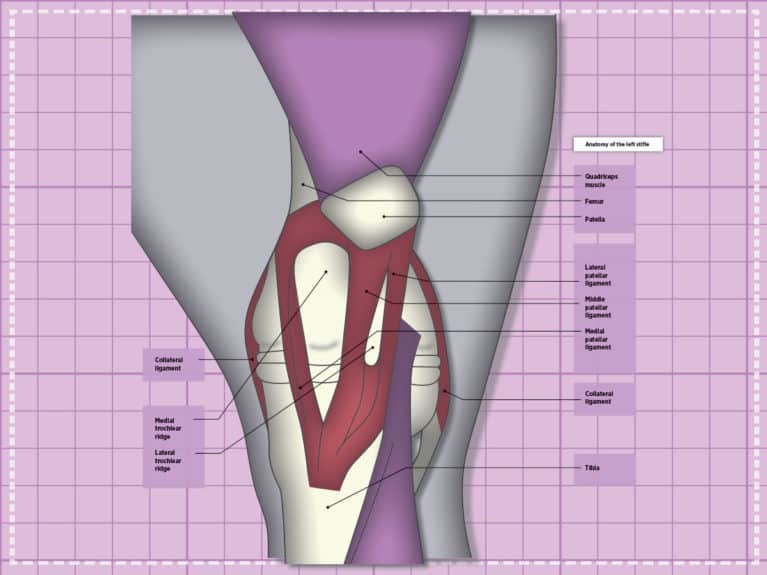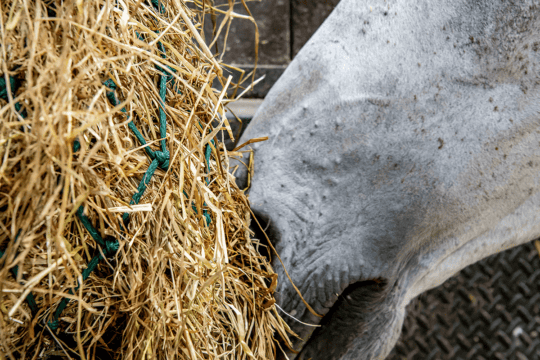How much do you know about the largest joint in your horse’s body? Vet Annamaria Nagy, from the Animal Health Trust, takes a close look at the stifle

It might be well-hidden within your horse, but the stifle is the largest joint in his body. It’s the equivalent of your knee and it helps to pull your horse’s hindleg forward, enabling him to move.
The stifle is a complex joint and is composed of…
- three bones…
- the lower end of the femur (thigh bone)
- the patella (knee cap)
- the upper end of the tibia (shin)
- two large joints…
- the femoropatellar joint between the femur and the patella
- the femorotibial joint between the femur and the tibia, which is divided into medial (inside) and lateral (outside) compartments
- two crescent shaped discs of fibrocartilage called the menisci, which sit between the femur and tibia. They have a shock-absorbing role, reduce concussion, provide cushioning and ensure the two bone ends come together consistently.
- several ligaments that provide stability…
- two collateral ligaments – one on either side of the stifle between the femur and the tibia
- three patellar ligaments, which attach the lower part of the patella to the tibia. The top of the patella is supported by the quadriceps femoris muscle
- small cruciate ligaments, which are inside the joint and prevent abnormal movement
- a joint capsule that surrounds the joints. Inside the capsule, synovial fluid provides lubrication and enables smooth movement of the bones when the joint is flexed and extended. It also provides nutrients to the cartilage within the joints.
Resting standing up
Your horse’s stifle isn’t just involved in movement, it also helps to support him in a standing position while he rests. The collective name for the parts of your horse’s forelegs and hindlegs that enable him to do this is the stay apparatus. Together these parts lock into place so that your horse can remain standing for long periods of time and while resting, using minimal muscular effort to support himself.
In the hindleg, the stay apparatus prevents the leg from collapsing by preventing flexion of the stifle and hock, and overextension of the fetlock, pastern and coffin joints. This happens in three phases…
- The stifle locks. Horses can lock their stifles because of the unique anatomy of the patella and its ligaments, and the lower end of the femur, which has a large ridge called the trochlear ridge. When the horse rests, the medial (inside) ligament of the patella gets hooked on the medial trochlear ridge on the femur, causing the stifle to lock in place.
- The reciprocal mechanism locks the hock. The reciprocal mechanism links the stifle and the hock with two tendons – one in the front of the thigh (peroneus tertius tendon) and one in the back (superficial digital flexor tendon). Because of this mechanism, the stifle and the hock must move together, so when the stifle is locked, the hock can’t move, either.
- The suspensory apparatus locks the lower leg. When the stifle and hock lock into position, the tendons and ligaments in
the lower limb secure the lower leg in position.
Looking after your horse’s stifle
Unfortunately, most injuries, especially the ones that are caused by trauma, can’t be prevented. As a general rule, it’s important that young horses’ fitness is built up slowly when exercise is started and that they only perform tasks that their muscles are strong enough for. Any increase and change in your horse’s work should be introduced gradually, whatever his age. Proper nutrition is important, especially for pregnant mares and foals, as nutrition is thought to play a role in the development of osteochondrosis.
Your horse’s stifle, like any part of his body, should be regularly monitored and if an unusual swelling or heat is noticed in the area, you should call your vet for advice. If you detect a stifle problem early, it may prevent the disease from progressing and result in a better prognosis.
To learn more about your horse’s stifle, including common problems that can affect it, pick up your copy of May Horse&Rider, on sale 6 April 2017.















